Governance, ethics and integrity -
VerifiedAdded on 2022/09/01
|15
|3772
|15
AI Summary
Contribute Materials
Your contribution can guide someone’s learning journey. Share your
documents today.
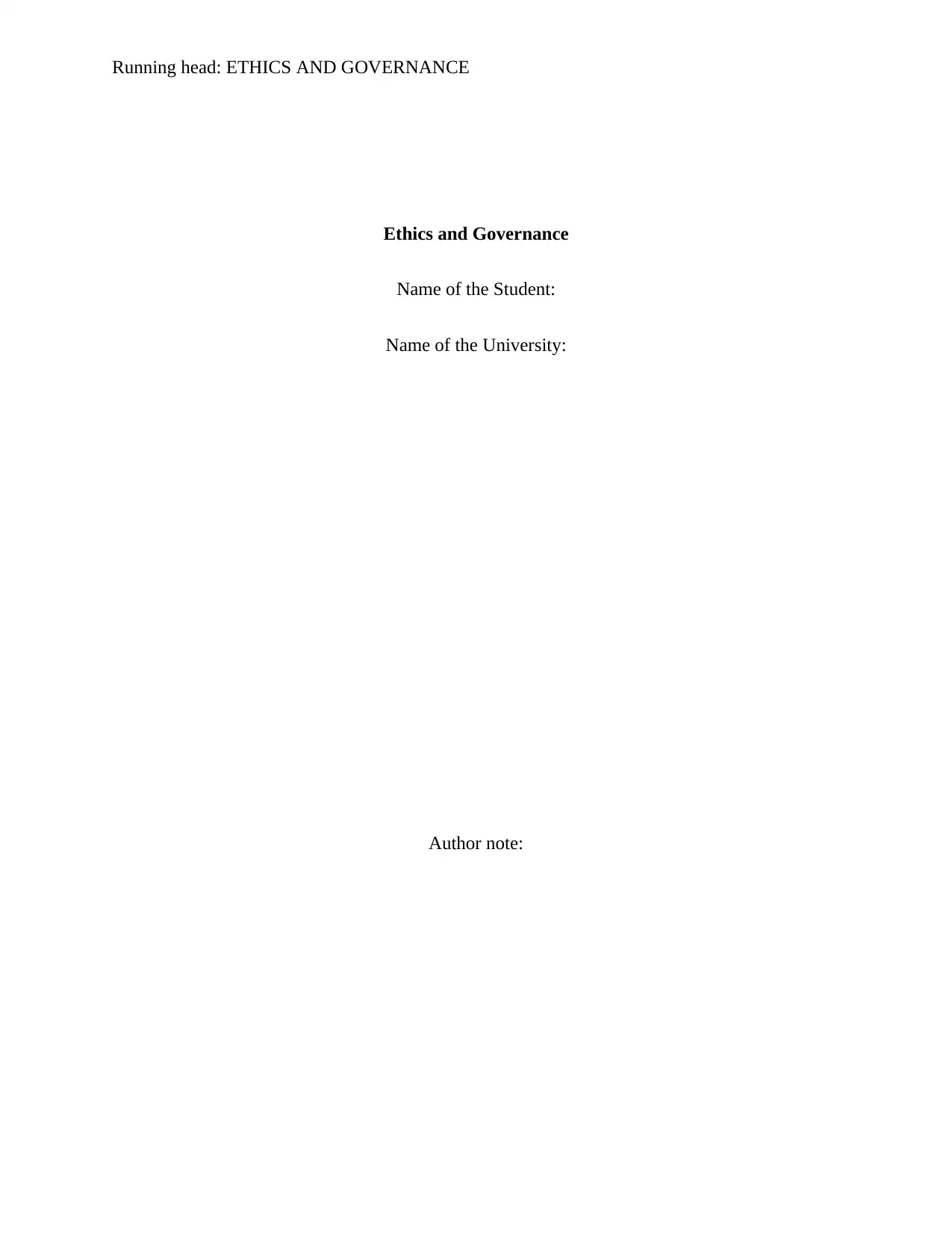
Running head: ETHICS AND GOVERNANCE
Ethics and Governance
Name of the Student:
Name of the University:
Author note:
Ethics and Governance
Name of the Student:
Name of the University:
Author note:
Secure Best Marks with AI Grader
Need help grading? Try our AI Grader for instant feedback on your assignments.
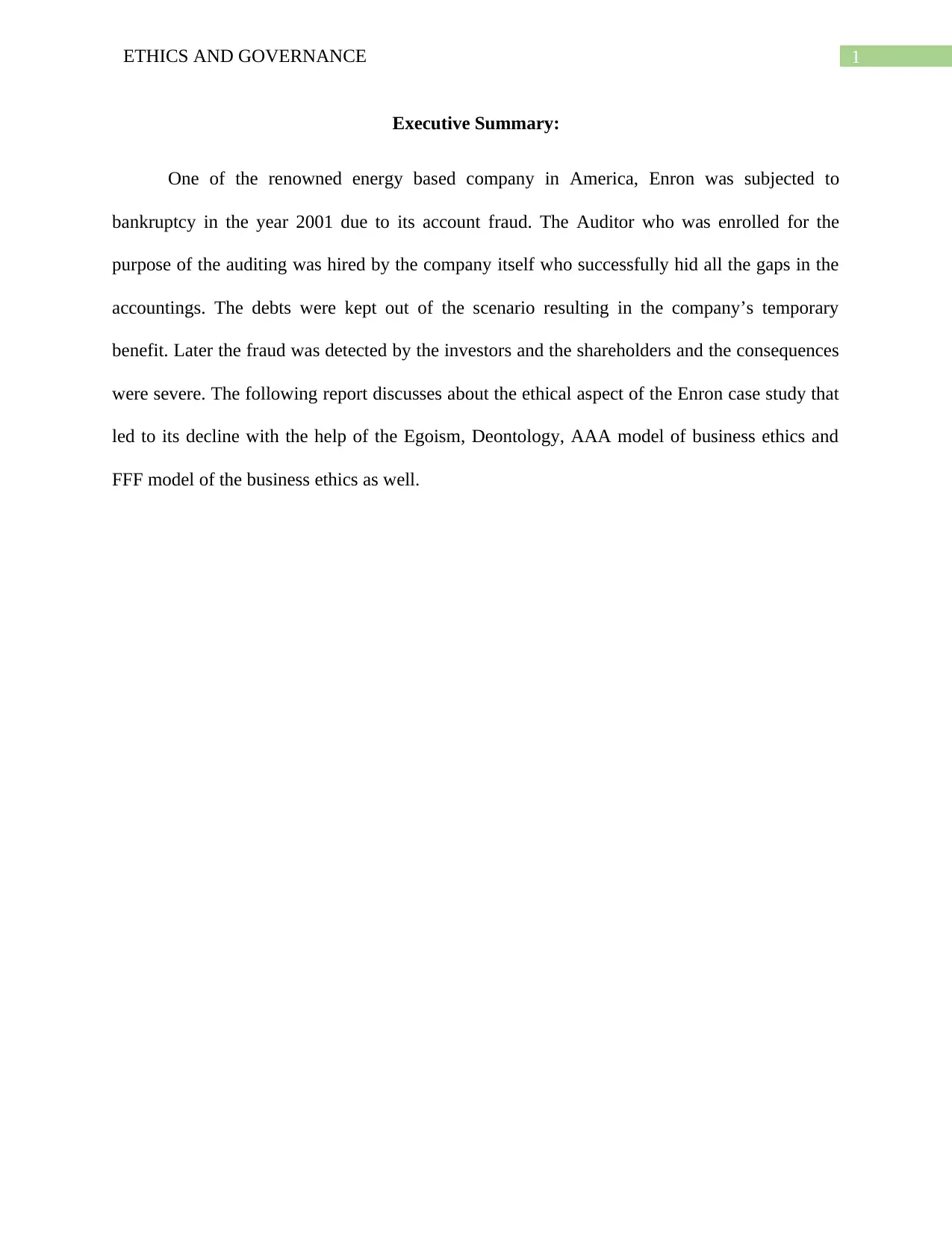
1ETHICS AND GOVERNANCE
Executive Summary:
One of the renowned energy based company in America, Enron was subjected to
bankruptcy in the year 2001 due to its account fraud. The Auditor who was enrolled for the
purpose of the auditing was hired by the company itself who successfully hid all the gaps in the
accountings. The debts were kept out of the scenario resulting in the company’s temporary
benefit. Later the fraud was detected by the investors and the shareholders and the consequences
were severe. The following report discusses about the ethical aspect of the Enron case study that
led to its decline with the help of the Egoism, Deontology, AAA model of business ethics and
FFF model of the business ethics as well.
Executive Summary:
One of the renowned energy based company in America, Enron was subjected to
bankruptcy in the year 2001 due to its account fraud. The Auditor who was enrolled for the
purpose of the auditing was hired by the company itself who successfully hid all the gaps in the
accountings. The debts were kept out of the scenario resulting in the company’s temporary
benefit. Later the fraud was detected by the investors and the shareholders and the consequences
were severe. The following report discusses about the ethical aspect of the Enron case study that
led to its decline with the help of the Egoism, Deontology, AAA model of business ethics and
FFF model of the business ethics as well.
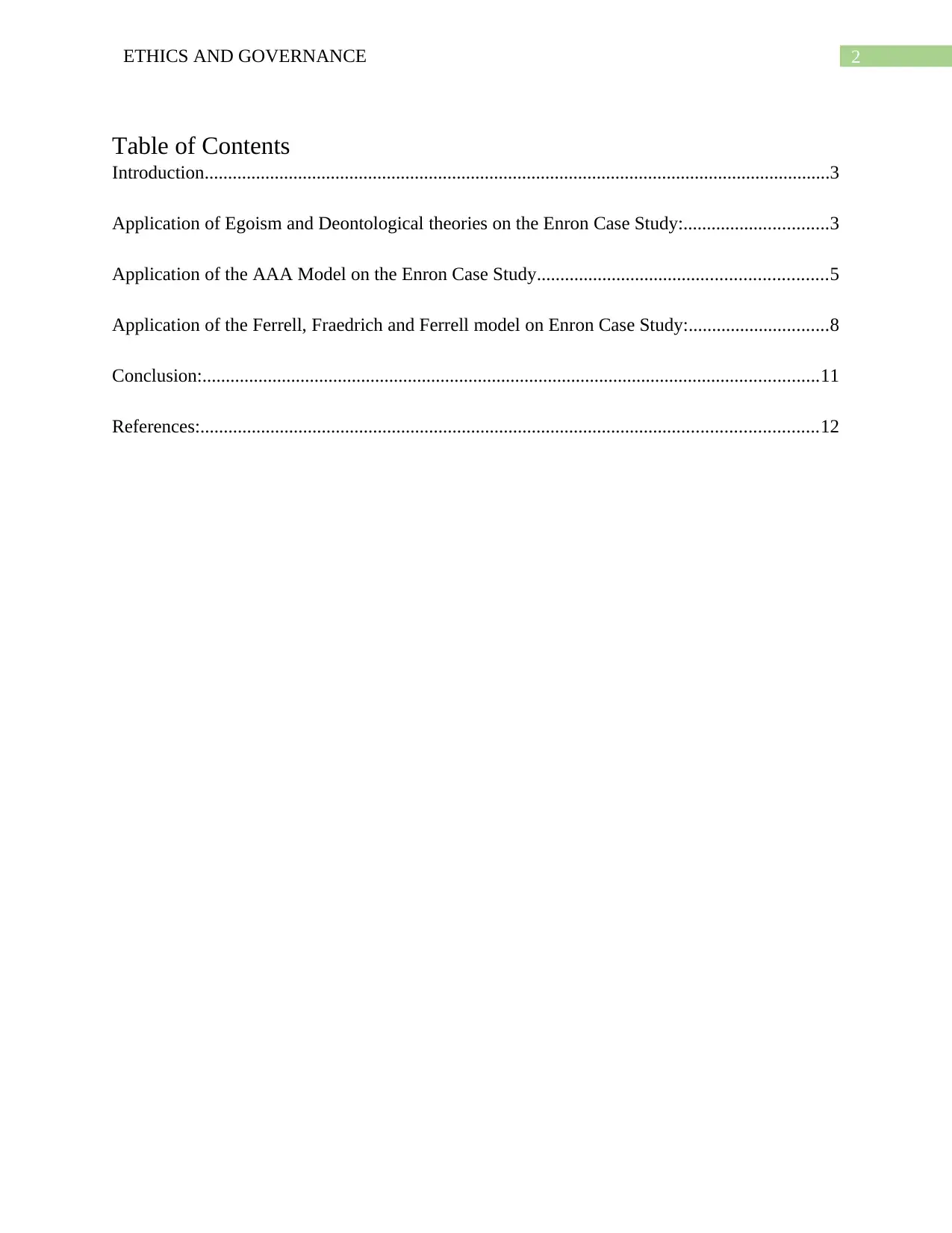
2ETHICS AND GOVERNANCE
Table of Contents
Introduction......................................................................................................................................3
Application of Egoism and Deontological theories on the Enron Case Study:...............................3
Application of the AAA Model on the Enron Case Study..............................................................5
Application of the Ferrell, Fraedrich and Ferrell model on Enron Case Study:..............................8
Conclusion:....................................................................................................................................11
References:....................................................................................................................................12
Table of Contents
Introduction......................................................................................................................................3
Application of Egoism and Deontological theories on the Enron Case Study:...............................3
Application of the AAA Model on the Enron Case Study..............................................................5
Application of the Ferrell, Fraedrich and Ferrell model on Enron Case Study:..............................8
Conclusion:....................................................................................................................................11
References:....................................................................................................................................12
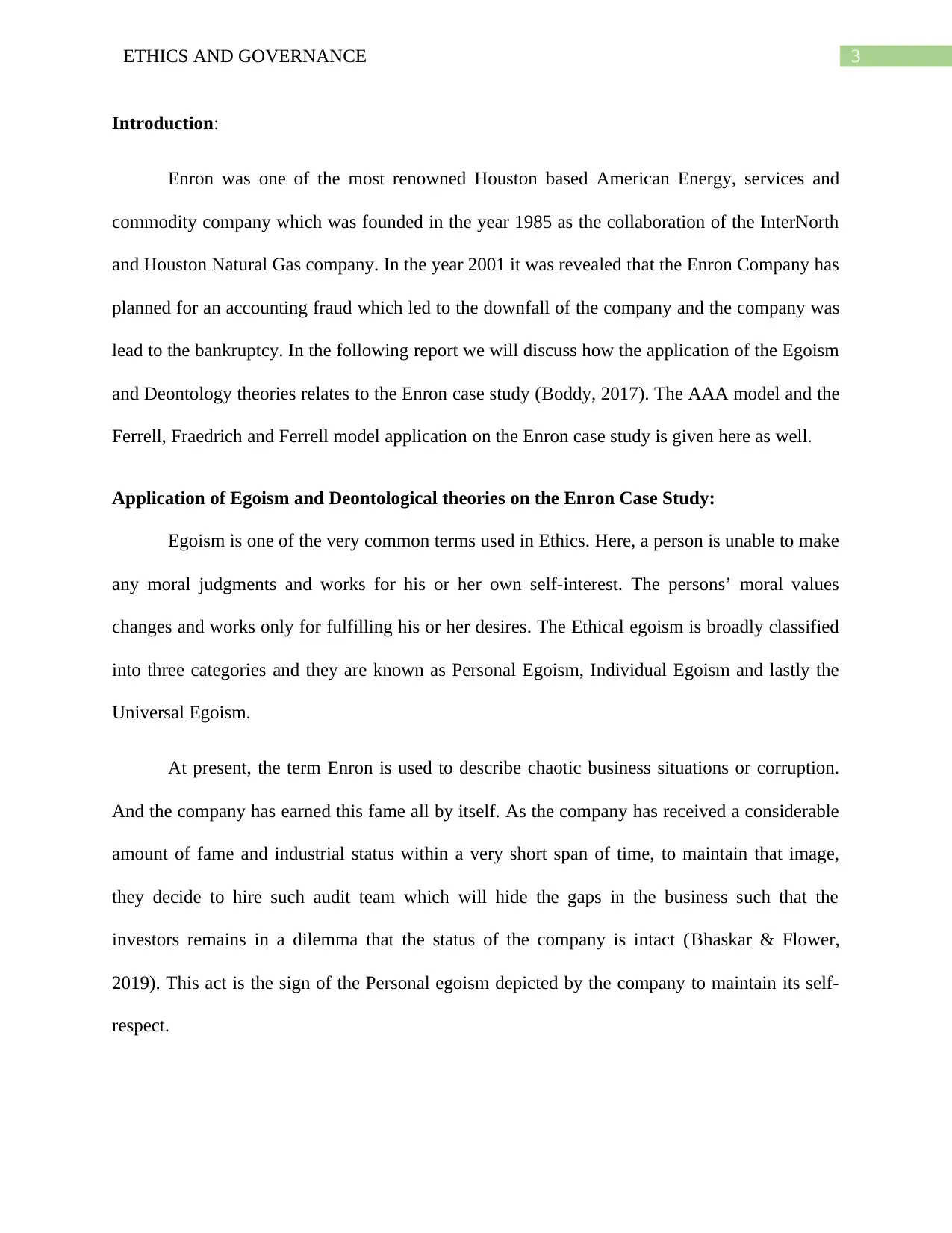
3ETHICS AND GOVERNANCE
Introduction:
Enron was one of the most renowned Houston based American Energy, services and
commodity company which was founded in the year 1985 as the collaboration of the InterNorth
and Houston Natural Gas company. In the year 2001 it was revealed that the Enron Company has
planned for an accounting fraud which led to the downfall of the company and the company was
lead to the bankruptcy. In the following report we will discuss how the application of the Egoism
and Deontology theories relates to the Enron case study (Boddy, 2017). The AAA model and the
Ferrell, Fraedrich and Ferrell model application on the Enron case study is given here as well.
Application of Egoism and Deontological theories on the Enron Case Study:
Egoism is one of the very common terms used in Ethics. Here, a person is unable to make
any moral judgments and works for his or her own self-interest. The persons’ moral values
changes and works only for fulfilling his or her desires. The Ethical egoism is broadly classified
into three categories and they are known as Personal Egoism, Individual Egoism and lastly the
Universal Egoism.
At present, the term Enron is used to describe chaotic business situations or corruption.
And the company has earned this fame all by itself. As the company has received a considerable
amount of fame and industrial status within a very short span of time, to maintain that image,
they decide to hire such audit team which will hide the gaps in the business such that the
investors remains in a dilemma that the status of the company is intact (Bhaskar & Flower,
2019). This act is the sign of the Personal egoism depicted by the company to maintain its self-
respect.
Introduction:
Enron was one of the most renowned Houston based American Energy, services and
commodity company which was founded in the year 1985 as the collaboration of the InterNorth
and Houston Natural Gas company. In the year 2001 it was revealed that the Enron Company has
planned for an accounting fraud which led to the downfall of the company and the company was
lead to the bankruptcy. In the following report we will discuss how the application of the Egoism
and Deontology theories relates to the Enron case study (Boddy, 2017). The AAA model and the
Ferrell, Fraedrich and Ferrell model application on the Enron case study is given here as well.
Application of Egoism and Deontological theories on the Enron Case Study:
Egoism is one of the very common terms used in Ethics. Here, a person is unable to make
any moral judgments and works for his or her own self-interest. The persons’ moral values
changes and works only for fulfilling his or her desires. The Ethical egoism is broadly classified
into three categories and they are known as Personal Egoism, Individual Egoism and lastly the
Universal Egoism.
At present, the term Enron is used to describe chaotic business situations or corruption.
And the company has earned this fame all by itself. As the company has received a considerable
amount of fame and industrial status within a very short span of time, to maintain that image,
they decide to hire such audit team which will hide the gaps in the business such that the
investors remains in a dilemma that the status of the company is intact (Bhaskar & Flower,
2019). This act is the sign of the Personal egoism depicted by the company to maintain its self-
respect.
Secure Best Marks with AI Grader
Need help grading? Try our AI Grader for instant feedback on your assignments.
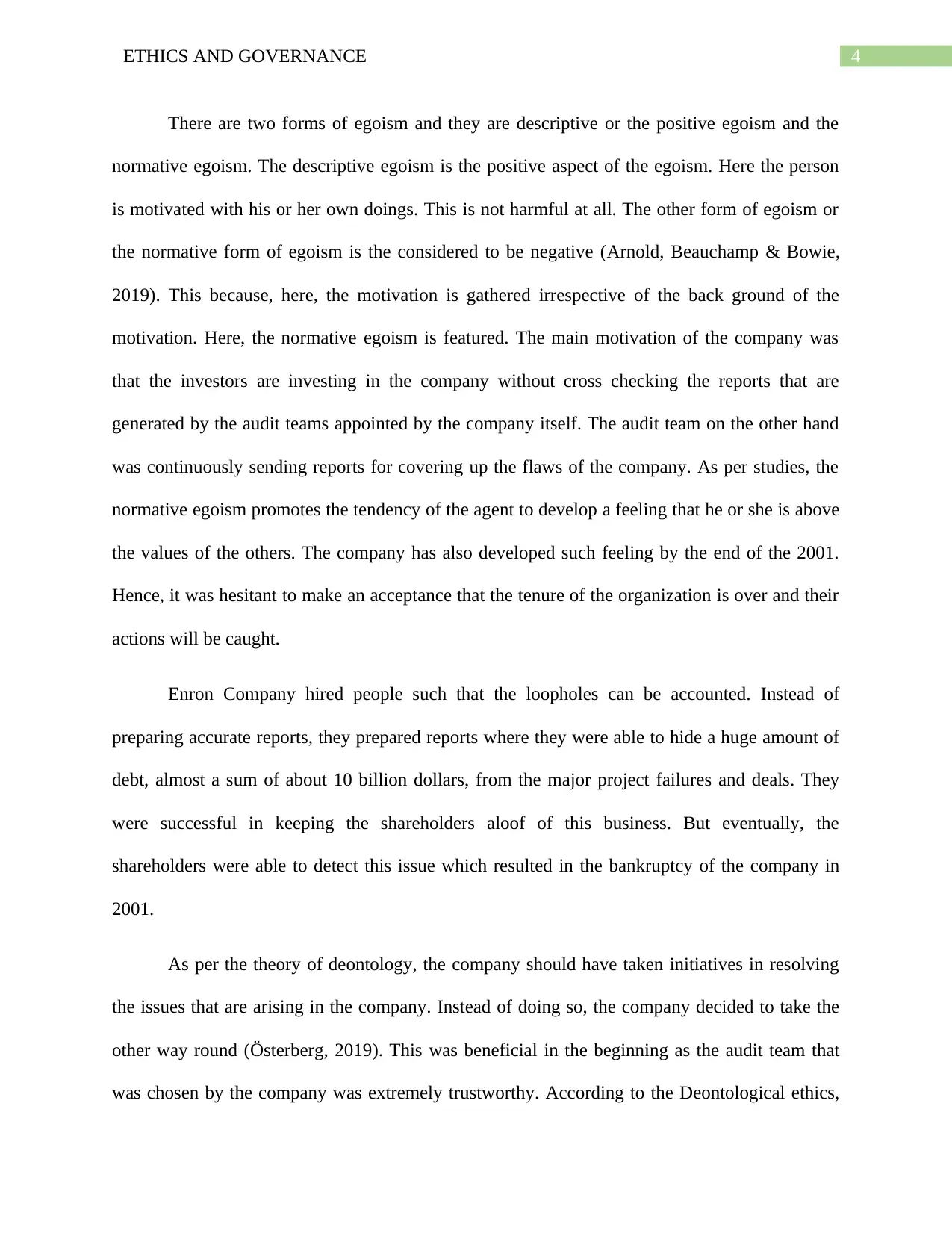
4ETHICS AND GOVERNANCE
There are two forms of egoism and they are descriptive or the positive egoism and the
normative egoism. The descriptive egoism is the positive aspect of the egoism. Here the person
is motivated with his or her own doings. This is not harmful at all. The other form of egoism or
the normative form of egoism is the considered to be negative (Arnold, Beauchamp & Bowie,
2019). This because, here, the motivation is gathered irrespective of the back ground of the
motivation. Here, the normative egoism is featured. The main motivation of the company was
that the investors are investing in the company without cross checking the reports that are
generated by the audit teams appointed by the company itself. The audit team on the other hand
was continuously sending reports for covering up the flaws of the company. As per studies, the
normative egoism promotes the tendency of the agent to develop a feeling that he or she is above
the values of the others. The company has also developed such feeling by the end of the 2001.
Hence, it was hesitant to make an acceptance that the tenure of the organization is over and their
actions will be caught.
Enron Company hired people such that the loopholes can be accounted. Instead of
preparing accurate reports, they prepared reports where they were able to hide a huge amount of
debt, almost a sum of about 10 billion dollars, from the major project failures and deals. They
were successful in keeping the shareholders aloof of this business. But eventually, the
shareholders were able to detect this issue which resulted in the bankruptcy of the company in
2001.
As per the theory of deontology, the company should have taken initiatives in resolving
the issues that are arising in the company. Instead of doing so, the company decided to take the
other way round (Österberg, 2019). This was beneficial in the beginning as the audit team that
was chosen by the company was extremely trustworthy. According to the Deontological ethics,
There are two forms of egoism and they are descriptive or the positive egoism and the
normative egoism. The descriptive egoism is the positive aspect of the egoism. Here the person
is motivated with his or her own doings. This is not harmful at all. The other form of egoism or
the normative form of egoism is the considered to be negative (Arnold, Beauchamp & Bowie,
2019). This because, here, the motivation is gathered irrespective of the back ground of the
motivation. Here, the normative egoism is featured. The main motivation of the company was
that the investors are investing in the company without cross checking the reports that are
generated by the audit teams appointed by the company itself. The audit team on the other hand
was continuously sending reports for covering up the flaws of the company. As per studies, the
normative egoism promotes the tendency of the agent to develop a feeling that he or she is above
the values of the others. The company has also developed such feeling by the end of the 2001.
Hence, it was hesitant to make an acceptance that the tenure of the organization is over and their
actions will be caught.
Enron Company hired people such that the loopholes can be accounted. Instead of
preparing accurate reports, they prepared reports where they were able to hide a huge amount of
debt, almost a sum of about 10 billion dollars, from the major project failures and deals. They
were successful in keeping the shareholders aloof of this business. But eventually, the
shareholders were able to detect this issue which resulted in the bankruptcy of the company in
2001.
As per the theory of deontology, the company should have taken initiatives in resolving
the issues that are arising in the company. Instead of doing so, the company decided to take the
other way round (Österberg, 2019). This was beneficial in the beginning as the audit team that
was chosen by the company was extremely trustworthy. According to the Deontological ethics,
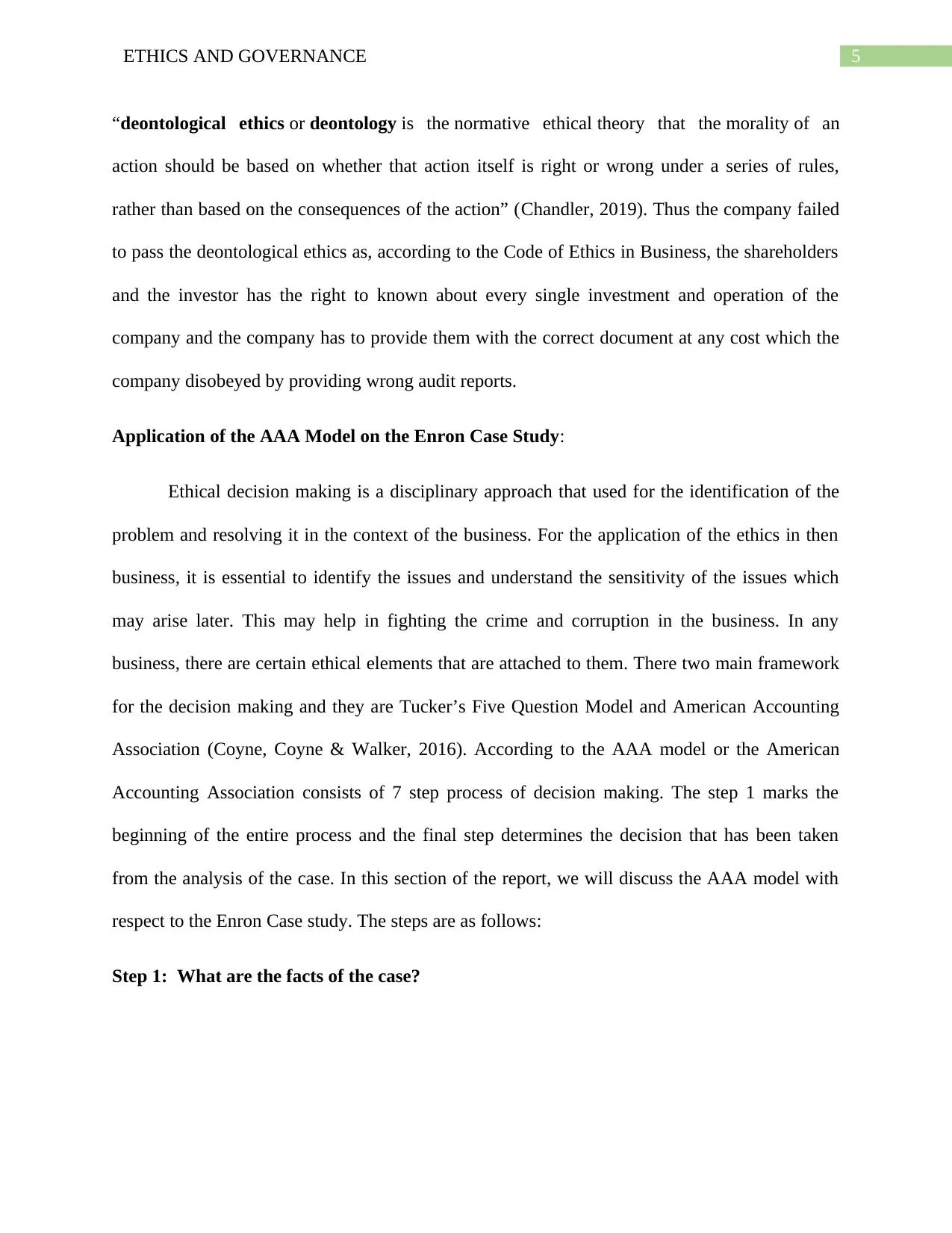
5ETHICS AND GOVERNANCE
“deontological ethics or deontology is the normative ethical theory that the morality of an
action should be based on whether that action itself is right or wrong under a series of rules,
rather than based on the consequences of the action” (Chandler, 2019). Thus the company failed
to pass the deontological ethics as, according to the Code of Ethics in Business, the shareholders
and the investor has the right to known about every single investment and operation of the
company and the company has to provide them with the correct document at any cost which the
company disobeyed by providing wrong audit reports.
Application of the AAA Model on the Enron Case Study:
Ethical decision making is a disciplinary approach that used for the identification of the
problem and resolving it in the context of the business. For the application of the ethics in then
business, it is essential to identify the issues and understand the sensitivity of the issues which
may arise later. This may help in fighting the crime and corruption in the business. In any
business, there are certain ethical elements that are attached to them. There two main framework
for the decision making and they are Tucker’s Five Question Model and American Accounting
Association (Coyne, Coyne & Walker, 2016). According to the AAA model or the American
Accounting Association consists of 7 step process of decision making. The step 1 marks the
beginning of the entire process and the final step determines the decision that has been taken
from the analysis of the case. In this section of the report, we will discuss the AAA model with
respect to the Enron Case study. The steps are as follows:
Step 1: What are the facts of the case?
“deontological ethics or deontology is the normative ethical theory that the morality of an
action should be based on whether that action itself is right or wrong under a series of rules,
rather than based on the consequences of the action” (Chandler, 2019). Thus the company failed
to pass the deontological ethics as, according to the Code of Ethics in Business, the shareholders
and the investor has the right to known about every single investment and operation of the
company and the company has to provide them with the correct document at any cost which the
company disobeyed by providing wrong audit reports.
Application of the AAA Model on the Enron Case Study:
Ethical decision making is a disciplinary approach that used for the identification of the
problem and resolving it in the context of the business. For the application of the ethics in then
business, it is essential to identify the issues and understand the sensitivity of the issues which
may arise later. This may help in fighting the crime and corruption in the business. In any
business, there are certain ethical elements that are attached to them. There two main framework
for the decision making and they are Tucker’s Five Question Model and American Accounting
Association (Coyne, Coyne & Walker, 2016). According to the AAA model or the American
Accounting Association consists of 7 step process of decision making. The step 1 marks the
beginning of the entire process and the final step determines the decision that has been taken
from the analysis of the case. In this section of the report, we will discuss the AAA model with
respect to the Enron Case study. The steps are as follows:
Step 1: What are the facts of the case?
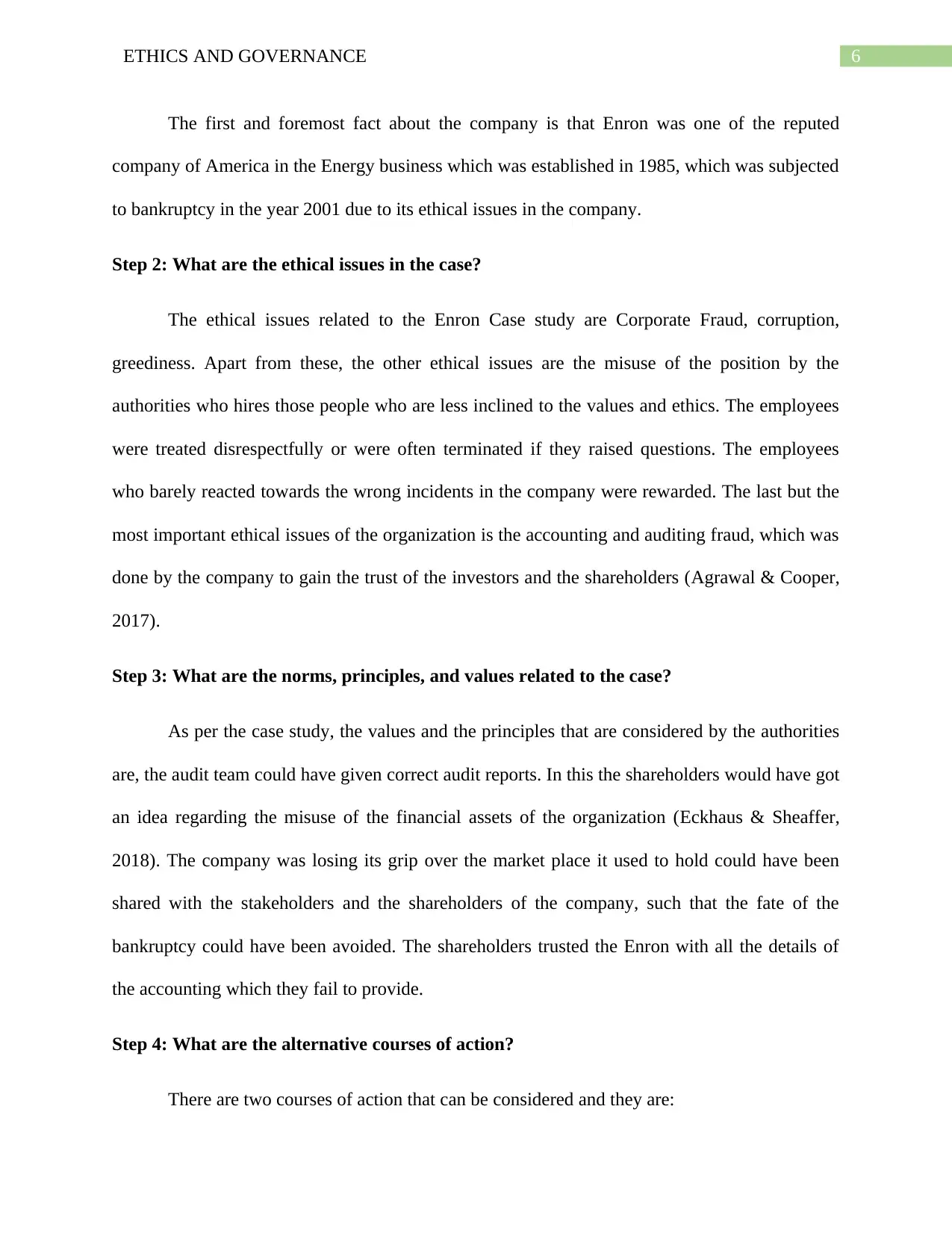
6ETHICS AND GOVERNANCE
The first and foremost fact about the company is that Enron was one of the reputed
company of America in the Energy business which was established in 1985, which was subjected
to bankruptcy in the year 2001 due to its ethical issues in the company.
Step 2: What are the ethical issues in the case?
The ethical issues related to the Enron Case study are Corporate Fraud, corruption,
greediness. Apart from these, the other ethical issues are the misuse of the position by the
authorities who hires those people who are less inclined to the values and ethics. The employees
were treated disrespectfully or were often terminated if they raised questions. The employees
who barely reacted towards the wrong incidents in the company were rewarded. The last but the
most important ethical issues of the organization is the accounting and auditing fraud, which was
done by the company to gain the trust of the investors and the shareholders (Agrawal & Cooper,
2017).
Step 3: What are the norms, principles, and values related to the case?
As per the case study, the values and the principles that are considered by the authorities
are, the audit team could have given correct audit reports. In this the shareholders would have got
an idea regarding the misuse of the financial assets of the organization (Eckhaus & Sheaffer,
2018). The company was losing its grip over the market place it used to hold could have been
shared with the stakeholders and the shareholders of the company, such that the fate of the
bankruptcy could have been avoided. The shareholders trusted the Enron with all the details of
the accounting which they fail to provide.
Step 4: What are the alternative courses of action?
There are two courses of action that can be considered and they are:
The first and foremost fact about the company is that Enron was one of the reputed
company of America in the Energy business which was established in 1985, which was subjected
to bankruptcy in the year 2001 due to its ethical issues in the company.
Step 2: What are the ethical issues in the case?
The ethical issues related to the Enron Case study are Corporate Fraud, corruption,
greediness. Apart from these, the other ethical issues are the misuse of the position by the
authorities who hires those people who are less inclined to the values and ethics. The employees
were treated disrespectfully or were often terminated if they raised questions. The employees
who barely reacted towards the wrong incidents in the company were rewarded. The last but the
most important ethical issues of the organization is the accounting and auditing fraud, which was
done by the company to gain the trust of the investors and the shareholders (Agrawal & Cooper,
2017).
Step 3: What are the norms, principles, and values related to the case?
As per the case study, the values and the principles that are considered by the authorities
are, the audit team could have given correct audit reports. In this the shareholders would have got
an idea regarding the misuse of the financial assets of the organization (Eckhaus & Sheaffer,
2018). The company was losing its grip over the market place it used to hold could have been
shared with the stakeholders and the shareholders of the company, such that the fate of the
bankruptcy could have been avoided. The shareholders trusted the Enron with all the details of
the accounting which they fail to provide.
Step 4: What are the alternative courses of action?
There are two courses of action that can be considered and they are:
Paraphrase This Document
Need a fresh take? Get an instant paraphrase of this document with our AI Paraphraser
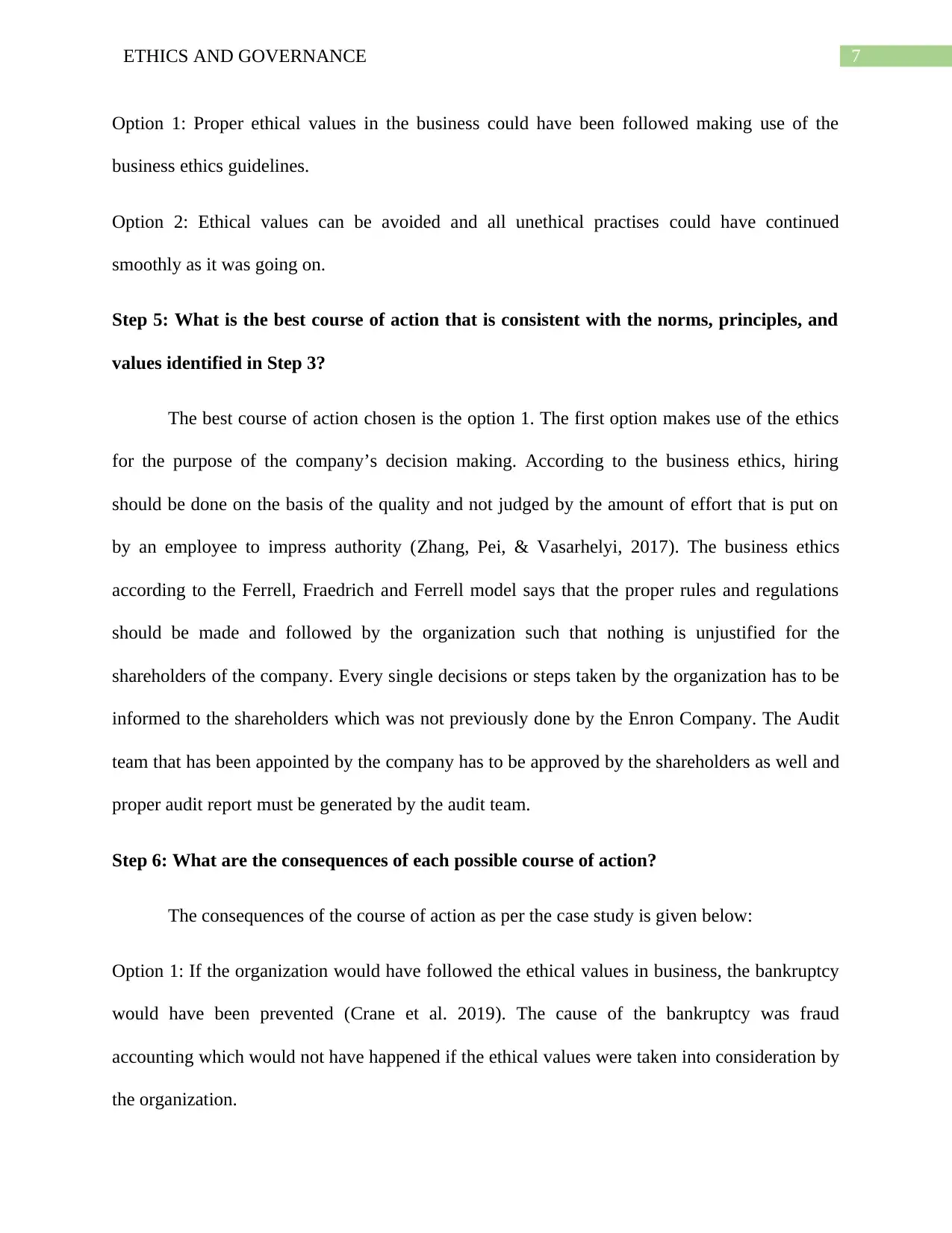
7ETHICS AND GOVERNANCE
Option 1: Proper ethical values in the business could have been followed making use of the
business ethics guidelines.
Option 2: Ethical values can be avoided and all unethical practises could have continued
smoothly as it was going on.
Step 5: What is the best course of action that is consistent with the norms, principles, and
values identified in Step 3?
The best course of action chosen is the option 1. The first option makes use of the ethics
for the purpose of the company’s decision making. According to the business ethics, hiring
should be done on the basis of the quality and not judged by the amount of effort that is put on
by an employee to impress authority (Zhang, Pei, & Vasarhelyi, 2017). The business ethics
according to the Ferrell, Fraedrich and Ferrell model says that the proper rules and regulations
should be made and followed by the organization such that nothing is unjustified for the
shareholders of the company. Every single decisions or steps taken by the organization has to be
informed to the shareholders which was not previously done by the Enron Company. The Audit
team that has been appointed by the company has to be approved by the shareholders as well and
proper audit report must be generated by the audit team.
Step 6: What are the consequences of each possible course of action?
The consequences of the course of action as per the case study is given below:
Option 1: If the organization would have followed the ethical values in business, the bankruptcy
would have been prevented (Crane et al. 2019). The cause of the bankruptcy was fraud
accounting which would not have happened if the ethical values were taken into consideration by
the organization.
Option 1: Proper ethical values in the business could have been followed making use of the
business ethics guidelines.
Option 2: Ethical values can be avoided and all unethical practises could have continued
smoothly as it was going on.
Step 5: What is the best course of action that is consistent with the norms, principles, and
values identified in Step 3?
The best course of action chosen is the option 1. The first option makes use of the ethics
for the purpose of the company’s decision making. According to the business ethics, hiring
should be done on the basis of the quality and not judged by the amount of effort that is put on
by an employee to impress authority (Zhang, Pei, & Vasarhelyi, 2017). The business ethics
according to the Ferrell, Fraedrich and Ferrell model says that the proper rules and regulations
should be made and followed by the organization such that nothing is unjustified for the
shareholders of the company. Every single decisions or steps taken by the organization has to be
informed to the shareholders which was not previously done by the Enron Company. The Audit
team that has been appointed by the company has to be approved by the shareholders as well and
proper audit report must be generated by the audit team.
Step 6: What are the consequences of each possible course of action?
The consequences of the course of action as per the case study is given below:
Option 1: If the organization would have followed the ethical values in business, the bankruptcy
would have been prevented (Crane et al. 2019). The cause of the bankruptcy was fraud
accounting which would not have happened if the ethical values were taken into consideration by
the organization.
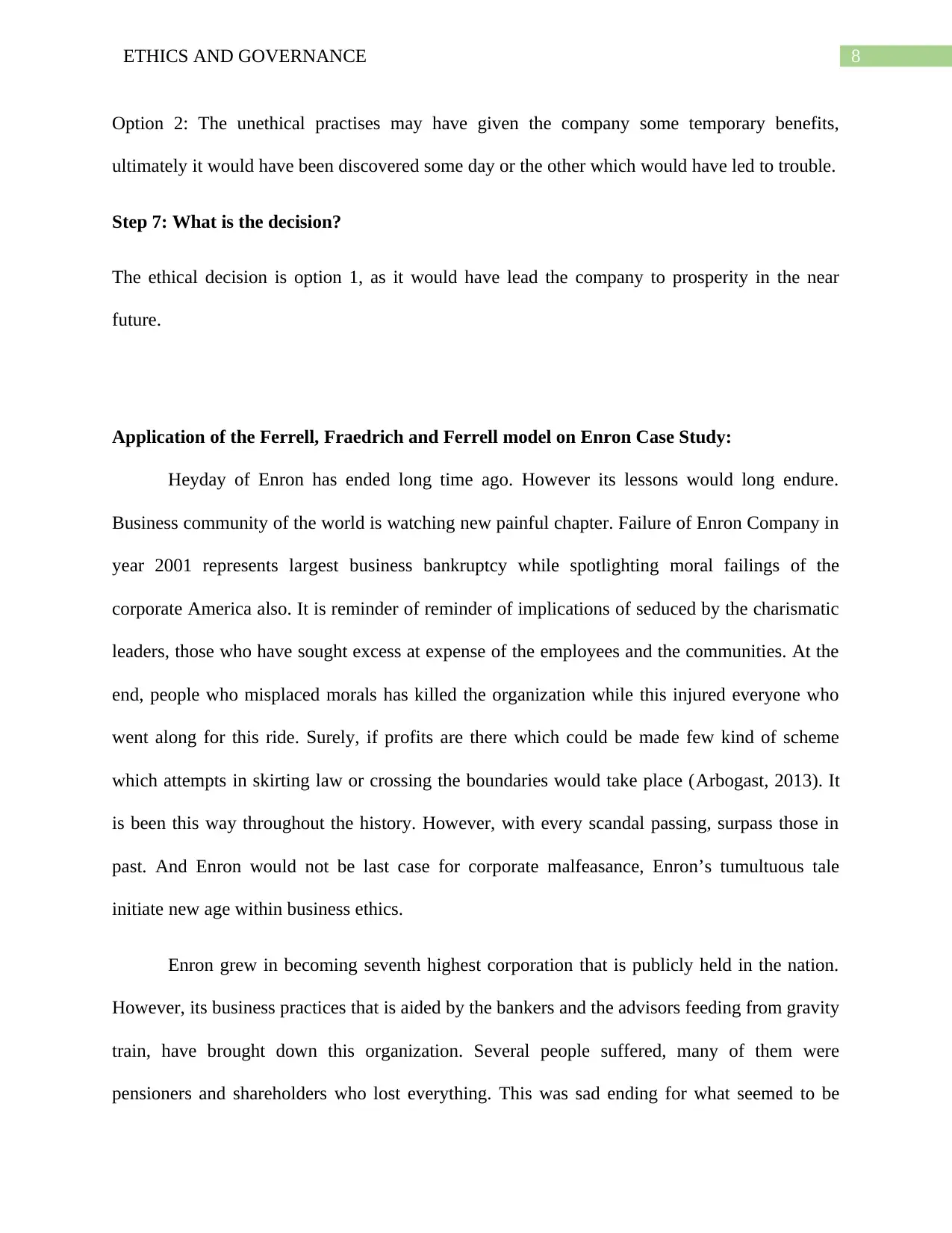
8ETHICS AND GOVERNANCE
Option 2: The unethical practises may have given the company some temporary benefits,
ultimately it would have been discovered some day or the other which would have led to trouble.
Step 7: What is the decision?
The ethical decision is option 1, as it would have lead the company to prosperity in the near
future.
Application of the Ferrell, Fraedrich and Ferrell model on Enron Case Study:
Heyday of Enron has ended long time ago. However its lessons would long endure.
Business community of the world is watching new painful chapter. Failure of Enron Company in
year 2001 represents largest business bankruptcy while spotlighting moral failings of the
corporate America also. It is reminder of reminder of implications of seduced by the charismatic
leaders, those who have sought excess at expense of the employees and the communities. At the
end, people who misplaced morals has killed the organization while this injured everyone who
went along for this ride. Surely, if profits are there which could be made few kind of scheme
which attempts in skirting law or crossing the boundaries would take place (Arbogast, 2013). It
is been this way throughout the history. However, with every scandal passing, surpass those in
past. And Enron would not be last case for corporate malfeasance, Enron’s tumultuous tale
initiate new age within business ethics.
Enron grew in becoming seventh highest corporation that is publicly held in the nation.
However, its business practices that is aided by the bankers and the advisors feeding from gravity
train, have brought down this organization. Several people suffered, many of them were
pensioners and shareholders who lost everything. This was sad ending for what seemed to be
Option 2: The unethical practises may have given the company some temporary benefits,
ultimately it would have been discovered some day or the other which would have led to trouble.
Step 7: What is the decision?
The ethical decision is option 1, as it would have lead the company to prosperity in the near
future.
Application of the Ferrell, Fraedrich and Ferrell model on Enron Case Study:
Heyday of Enron has ended long time ago. However its lessons would long endure.
Business community of the world is watching new painful chapter. Failure of Enron Company in
year 2001 represents largest business bankruptcy while spotlighting moral failings of the
corporate America also. It is reminder of reminder of implications of seduced by the charismatic
leaders, those who have sought excess at expense of the employees and the communities. At the
end, people who misplaced morals has killed the organization while this injured everyone who
went along for this ride. Surely, if profits are there which could be made few kind of scheme
which attempts in skirting law or crossing the boundaries would take place (Arbogast, 2013). It
is been this way throughout the history. However, with every scandal passing, surpass those in
past. And Enron would not be last case for corporate malfeasance, Enron’s tumultuous tale
initiate new age within business ethics.
Enron grew in becoming seventh highest corporation that is publicly held in the nation.
However, its business practices that is aided by the bankers and the advisors feeding from gravity
train, have brought down this organization. Several people suffered, many of them were
pensioners and shareholders who lost everything. This was sad ending for what seemed to be
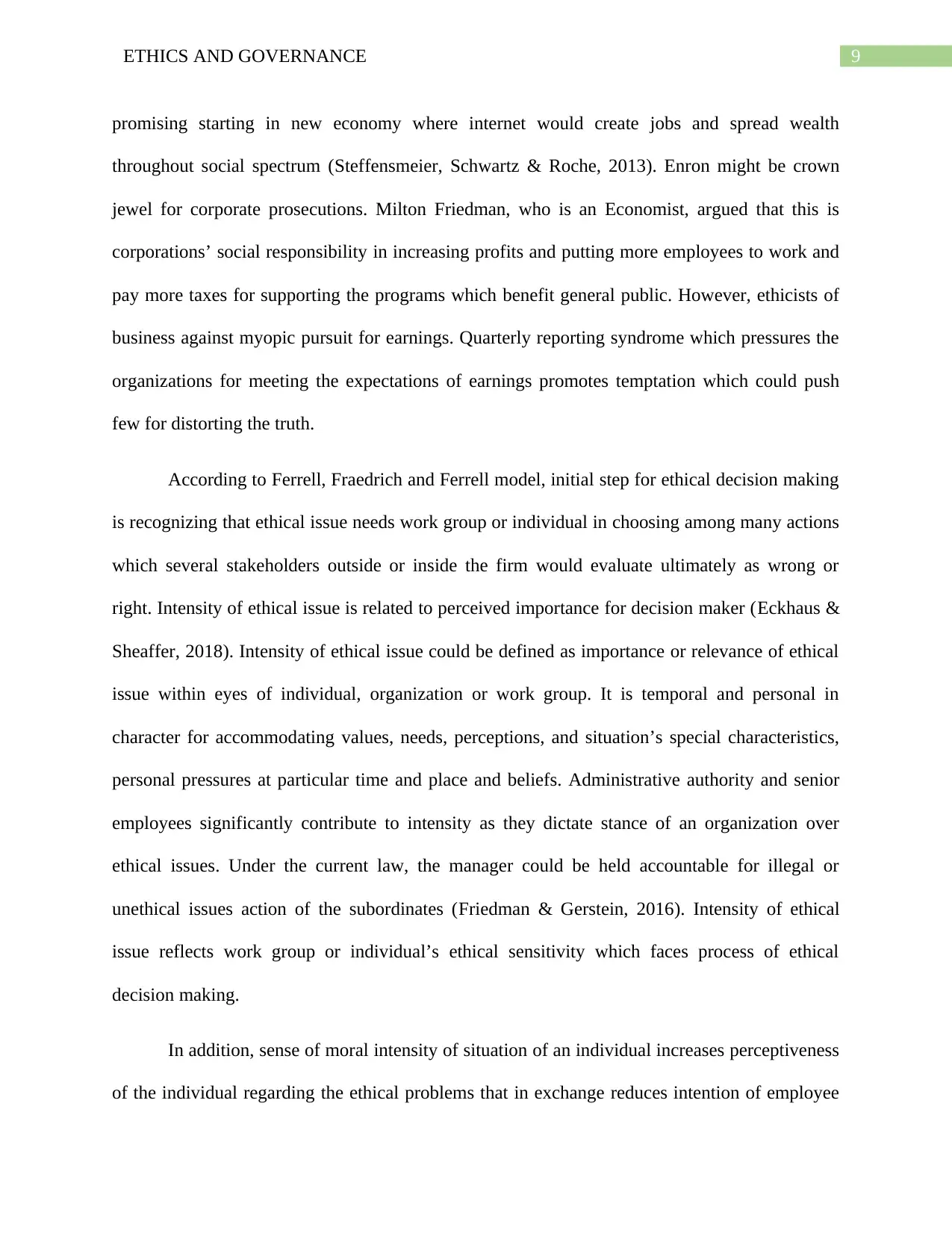
9ETHICS AND GOVERNANCE
promising starting in new economy where internet would create jobs and spread wealth
throughout social spectrum (Steffensmeier, Schwartz & Roche, 2013). Enron might be crown
jewel for corporate prosecutions. Milton Friedman, who is an Economist, argued that this is
corporations’ social responsibility in increasing profits and putting more employees to work and
pay more taxes for supporting the programs which benefit general public. However, ethicists of
business against myopic pursuit for earnings. Quarterly reporting syndrome which pressures the
organizations for meeting the expectations of earnings promotes temptation which could push
few for distorting the truth.
According to Ferrell, Fraedrich and Ferrell model, initial step for ethical decision making
is recognizing that ethical issue needs work group or individual in choosing among many actions
which several stakeholders outside or inside the firm would evaluate ultimately as wrong or
right. Intensity of ethical issue is related to perceived importance for decision maker (Eckhaus &
Sheaffer, 2018). Intensity of ethical issue could be defined as importance or relevance of ethical
issue within eyes of individual, organization or work group. It is temporal and personal in
character for accommodating values, needs, perceptions, and situation’s special characteristics,
personal pressures at particular time and place and beliefs. Administrative authority and senior
employees significantly contribute to intensity as they dictate stance of an organization over
ethical issues. Under the current law, the manager could be held accountable for illegal or
unethical issues action of the subordinates (Friedman & Gerstein, 2016). Intensity of ethical
issue reflects work group or individual’s ethical sensitivity which faces process of ethical
decision making.
In addition, sense of moral intensity of situation of an individual increases perceptiveness
of the individual regarding the ethical problems that in exchange reduces intention of employee
promising starting in new economy where internet would create jobs and spread wealth
throughout social spectrum (Steffensmeier, Schwartz & Roche, 2013). Enron might be crown
jewel for corporate prosecutions. Milton Friedman, who is an Economist, argued that this is
corporations’ social responsibility in increasing profits and putting more employees to work and
pay more taxes for supporting the programs which benefit general public. However, ethicists of
business against myopic pursuit for earnings. Quarterly reporting syndrome which pressures the
organizations for meeting the expectations of earnings promotes temptation which could push
few for distorting the truth.
According to Ferrell, Fraedrich and Ferrell model, initial step for ethical decision making
is recognizing that ethical issue needs work group or individual in choosing among many actions
which several stakeholders outside or inside the firm would evaluate ultimately as wrong or
right. Intensity of ethical issue is related to perceived importance for decision maker (Eckhaus &
Sheaffer, 2018). Intensity of ethical issue could be defined as importance or relevance of ethical
issue within eyes of individual, organization or work group. It is temporal and personal in
character for accommodating values, needs, perceptions, and situation’s special characteristics,
personal pressures at particular time and place and beliefs. Administrative authority and senior
employees significantly contribute to intensity as they dictate stance of an organization over
ethical issues. Under the current law, the manager could be held accountable for illegal or
unethical issues action of the subordinates (Friedman & Gerstein, 2016). Intensity of ethical
issue reflects work group or individual’s ethical sensitivity which faces process of ethical
decision making.
In addition, sense of moral intensity of situation of an individual increases perceptiveness
of the individual regarding the ethical problems that in exchange reduces intention of employee
Secure Best Marks with AI Grader
Need help grading? Try our AI Grader for instant feedback on your assignments.
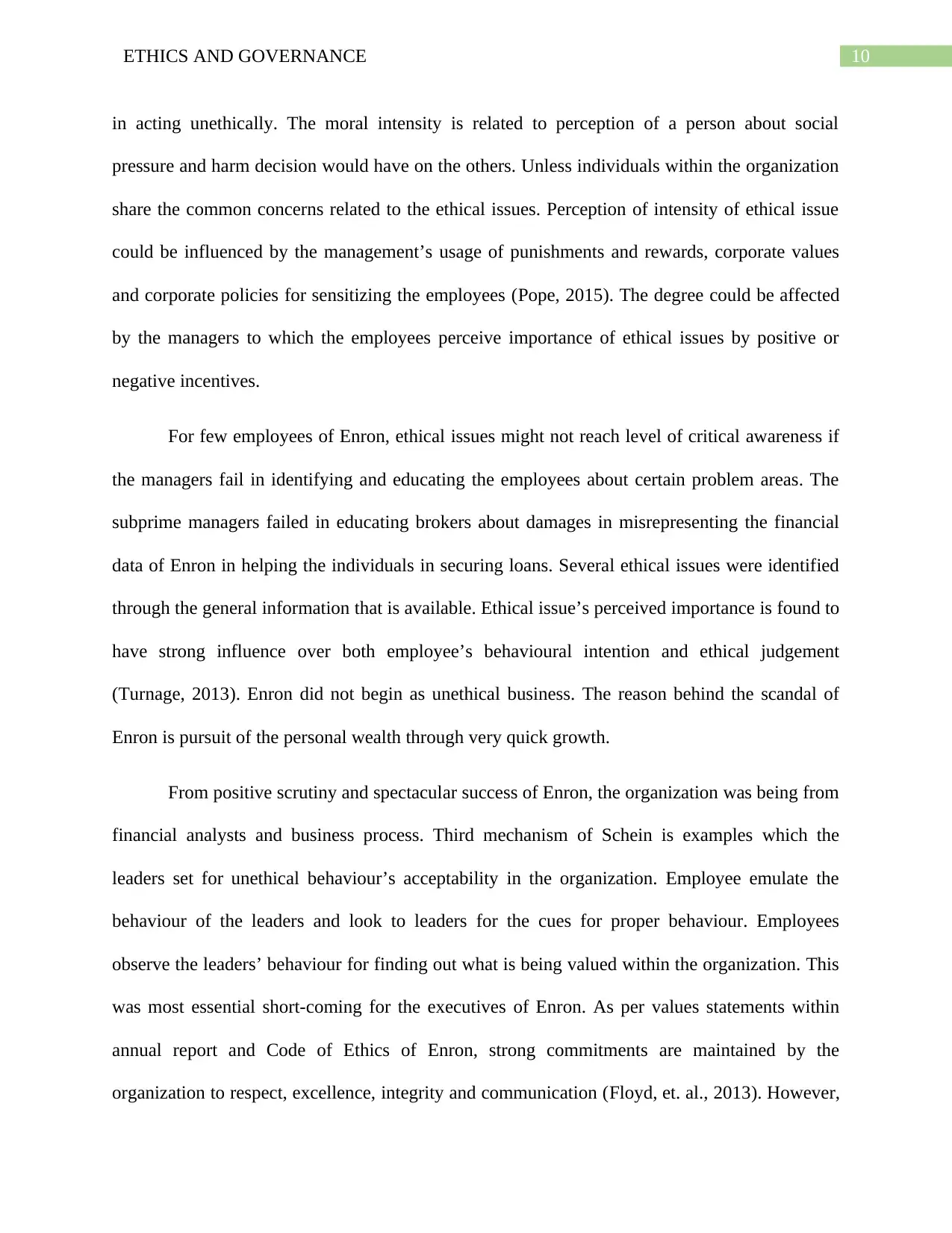
10ETHICS AND GOVERNANCE
in acting unethically. The moral intensity is related to perception of a person about social
pressure and harm decision would have on the others. Unless individuals within the organization
share the common concerns related to the ethical issues. Perception of intensity of ethical issue
could be influenced by the management’s usage of punishments and rewards, corporate values
and corporate policies for sensitizing the employees (Pope, 2015). The degree could be affected
by the managers to which the employees perceive importance of ethical issues by positive or
negative incentives.
For few employees of Enron, ethical issues might not reach level of critical awareness if
the managers fail in identifying and educating the employees about certain problem areas. The
subprime managers failed in educating brokers about damages in misrepresenting the financial
data of Enron in helping the individuals in securing loans. Several ethical issues were identified
through the general information that is available. Ethical issue’s perceived importance is found to
have strong influence over both employee’s behavioural intention and ethical judgement
(Turnage, 2013). Enron did not begin as unethical business. The reason behind the scandal of
Enron is pursuit of the personal wealth through very quick growth.
From positive scrutiny and spectacular success of Enron, the organization was being from
financial analysts and business process. Third mechanism of Schein is examples which the
leaders set for unethical behaviour’s acceptability in the organization. Employee emulate the
behaviour of the leaders and look to leaders for the cues for proper behaviour. Employees
observe the leaders’ behaviour for finding out what is being valued within the organization. This
was most essential short-coming for the executives of Enron. As per values statements within
annual report and Code of Ethics of Enron, strong commitments are maintained by the
organization to respect, excellence, integrity and communication (Floyd, et. al., 2013). However,
in acting unethically. The moral intensity is related to perception of a person about social
pressure and harm decision would have on the others. Unless individuals within the organization
share the common concerns related to the ethical issues. Perception of intensity of ethical issue
could be influenced by the management’s usage of punishments and rewards, corporate values
and corporate policies for sensitizing the employees (Pope, 2015). The degree could be affected
by the managers to which the employees perceive importance of ethical issues by positive or
negative incentives.
For few employees of Enron, ethical issues might not reach level of critical awareness if
the managers fail in identifying and educating the employees about certain problem areas. The
subprime managers failed in educating brokers about damages in misrepresenting the financial
data of Enron in helping the individuals in securing loans. Several ethical issues were identified
through the general information that is available. Ethical issue’s perceived importance is found to
have strong influence over both employee’s behavioural intention and ethical judgement
(Turnage, 2013). Enron did not begin as unethical business. The reason behind the scandal of
Enron is pursuit of the personal wealth through very quick growth.
From positive scrutiny and spectacular success of Enron, the organization was being from
financial analysts and business process. Third mechanism of Schein is examples which the
leaders set for unethical behaviour’s acceptability in the organization. Employee emulate the
behaviour of the leaders and look to leaders for the cues for proper behaviour. Employees
observe the leaders’ behaviour for finding out what is being valued within the organization. This
was most essential short-coming for the executives of Enron. As per values statements within
annual report and Code of Ethics of Enron, strong commitments are maintained by the
organization to respect, excellence, integrity and communication (Floyd, et. al., 2013). However,
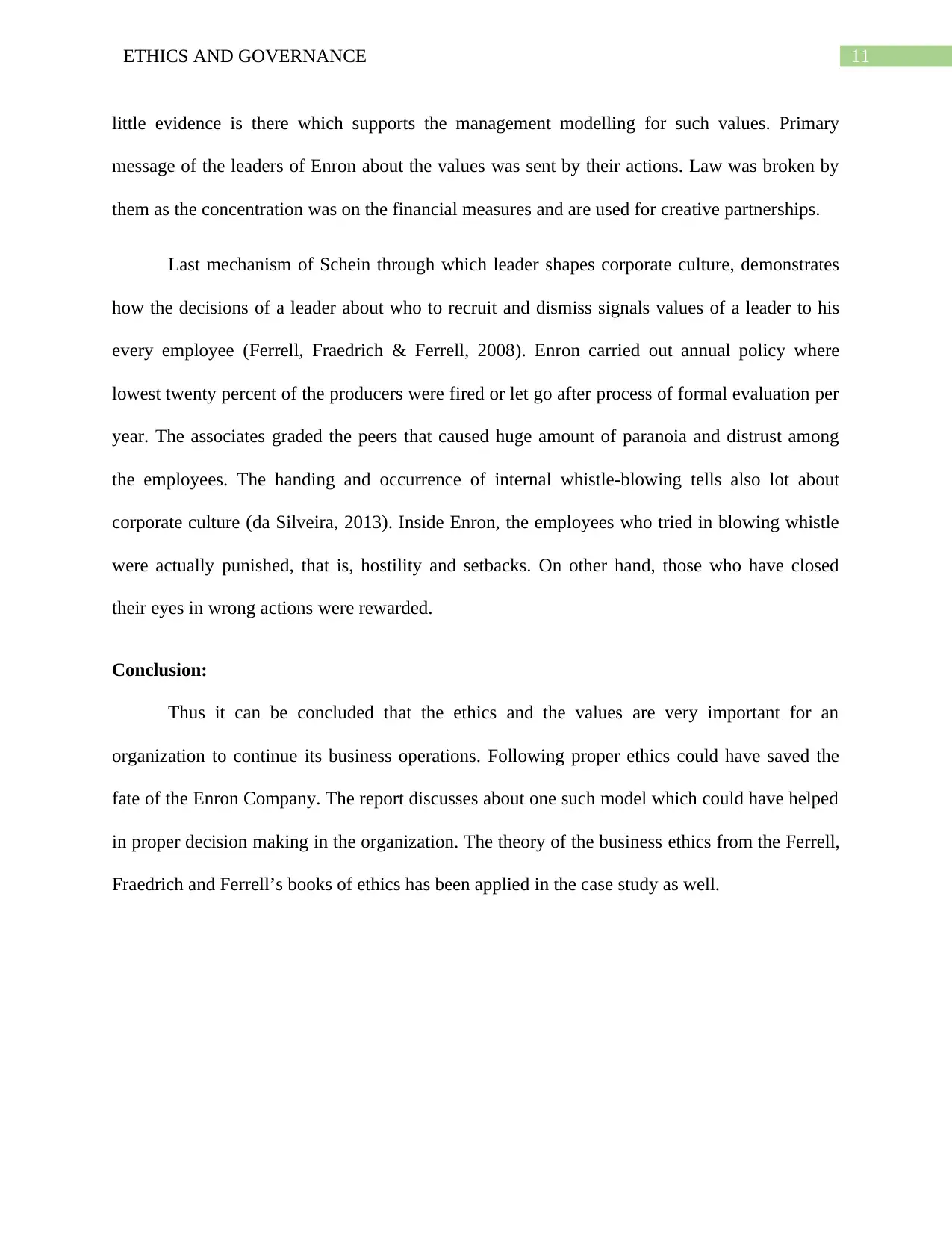
11ETHICS AND GOVERNANCE
little evidence is there which supports the management modelling for such values. Primary
message of the leaders of Enron about the values was sent by their actions. Law was broken by
them as the concentration was on the financial measures and are used for creative partnerships.
Last mechanism of Schein through which leader shapes corporate culture, demonstrates
how the decisions of a leader about who to recruit and dismiss signals values of a leader to his
every employee (Ferrell, Fraedrich & Ferrell, 2008). Enron carried out annual policy where
lowest twenty percent of the producers were fired or let go after process of formal evaluation per
year. The associates graded the peers that caused huge amount of paranoia and distrust among
the employees. The handing and occurrence of internal whistle-blowing tells also lot about
corporate culture (da Silveira, 2013). Inside Enron, the employees who tried in blowing whistle
were actually punished, that is, hostility and setbacks. On other hand, those who have closed
their eyes in wrong actions were rewarded.
Conclusion:
Thus it can be concluded that the ethics and the values are very important for an
organization to continue its business operations. Following proper ethics could have saved the
fate of the Enron Company. The report discusses about one such model which could have helped
in proper decision making in the organization. The theory of the business ethics from the Ferrell,
Fraedrich and Ferrell’s books of ethics has been applied in the case study as well.
little evidence is there which supports the management modelling for such values. Primary
message of the leaders of Enron about the values was sent by their actions. Law was broken by
them as the concentration was on the financial measures and are used for creative partnerships.
Last mechanism of Schein through which leader shapes corporate culture, demonstrates
how the decisions of a leader about who to recruit and dismiss signals values of a leader to his
every employee (Ferrell, Fraedrich & Ferrell, 2008). Enron carried out annual policy where
lowest twenty percent of the producers were fired or let go after process of formal evaluation per
year. The associates graded the peers that caused huge amount of paranoia and distrust among
the employees. The handing and occurrence of internal whistle-blowing tells also lot about
corporate culture (da Silveira, 2013). Inside Enron, the employees who tried in blowing whistle
were actually punished, that is, hostility and setbacks. On other hand, those who have closed
their eyes in wrong actions were rewarded.
Conclusion:
Thus it can be concluded that the ethics and the values are very important for an
organization to continue its business operations. Following proper ethics could have saved the
fate of the Enron Company. The report discusses about one such model which could have helped
in proper decision making in the organization. The theory of the business ethics from the Ferrell,
Fraedrich and Ferrell’s books of ethics has been applied in the case study as well.
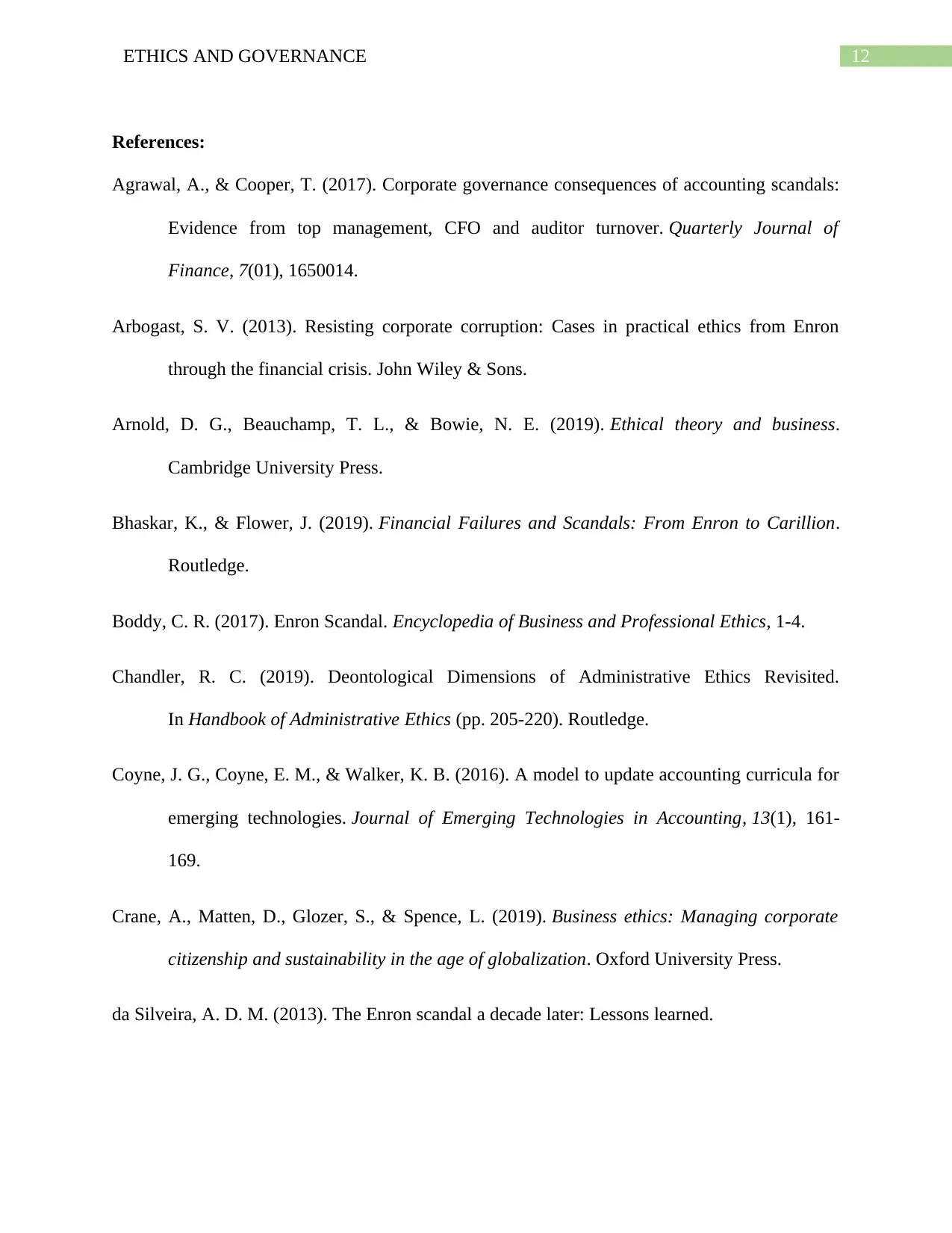
12ETHICS AND GOVERNANCE
References:
Agrawal, A., & Cooper, T. (2017). Corporate governance consequences of accounting scandals:
Evidence from top management, CFO and auditor turnover. Quarterly Journal of
Finance, 7(01), 1650014.
Arbogast, S. V. (2013). Resisting corporate corruption: Cases in practical ethics from Enron
through the financial crisis. John Wiley & Sons.
Arnold, D. G., Beauchamp, T. L., & Bowie, N. E. (2019). Ethical theory and business.
Cambridge University Press.
Bhaskar, K., & Flower, J. (2019). Financial Failures and Scandals: From Enron to Carillion.
Routledge.
Boddy, C. R. (2017). Enron Scandal. Encyclopedia of Business and Professional Ethics, 1-4.
Chandler, R. C. (2019). Deontological Dimensions of Administrative Ethics Revisited.
In Handbook of Administrative Ethics (pp. 205-220). Routledge.
Coyne, J. G., Coyne, E. M., & Walker, K. B. (2016). A model to update accounting curricula for
emerging technologies. Journal of Emerging Technologies in Accounting, 13(1), 161-
169.
Crane, A., Matten, D., Glozer, S., & Spence, L. (2019). Business ethics: Managing corporate
citizenship and sustainability in the age of globalization. Oxford University Press.
da Silveira, A. D. M. (2013). The Enron scandal a decade later: Lessons learned.
References:
Agrawal, A., & Cooper, T. (2017). Corporate governance consequences of accounting scandals:
Evidence from top management, CFO and auditor turnover. Quarterly Journal of
Finance, 7(01), 1650014.
Arbogast, S. V. (2013). Resisting corporate corruption: Cases in practical ethics from Enron
through the financial crisis. John Wiley & Sons.
Arnold, D. G., Beauchamp, T. L., & Bowie, N. E. (2019). Ethical theory and business.
Cambridge University Press.
Bhaskar, K., & Flower, J. (2019). Financial Failures and Scandals: From Enron to Carillion.
Routledge.
Boddy, C. R. (2017). Enron Scandal. Encyclopedia of Business and Professional Ethics, 1-4.
Chandler, R. C. (2019). Deontological Dimensions of Administrative Ethics Revisited.
In Handbook of Administrative Ethics (pp. 205-220). Routledge.
Coyne, J. G., Coyne, E. M., & Walker, K. B. (2016). A model to update accounting curricula for
emerging technologies. Journal of Emerging Technologies in Accounting, 13(1), 161-
169.
Crane, A., Matten, D., Glozer, S., & Spence, L. (2019). Business ethics: Managing corporate
citizenship and sustainability in the age of globalization. Oxford University Press.
da Silveira, A. D. M. (2013). The Enron scandal a decade later: Lessons learned.
Paraphrase This Document
Need a fresh take? Get an instant paraphrase of this document with our AI Paraphraser
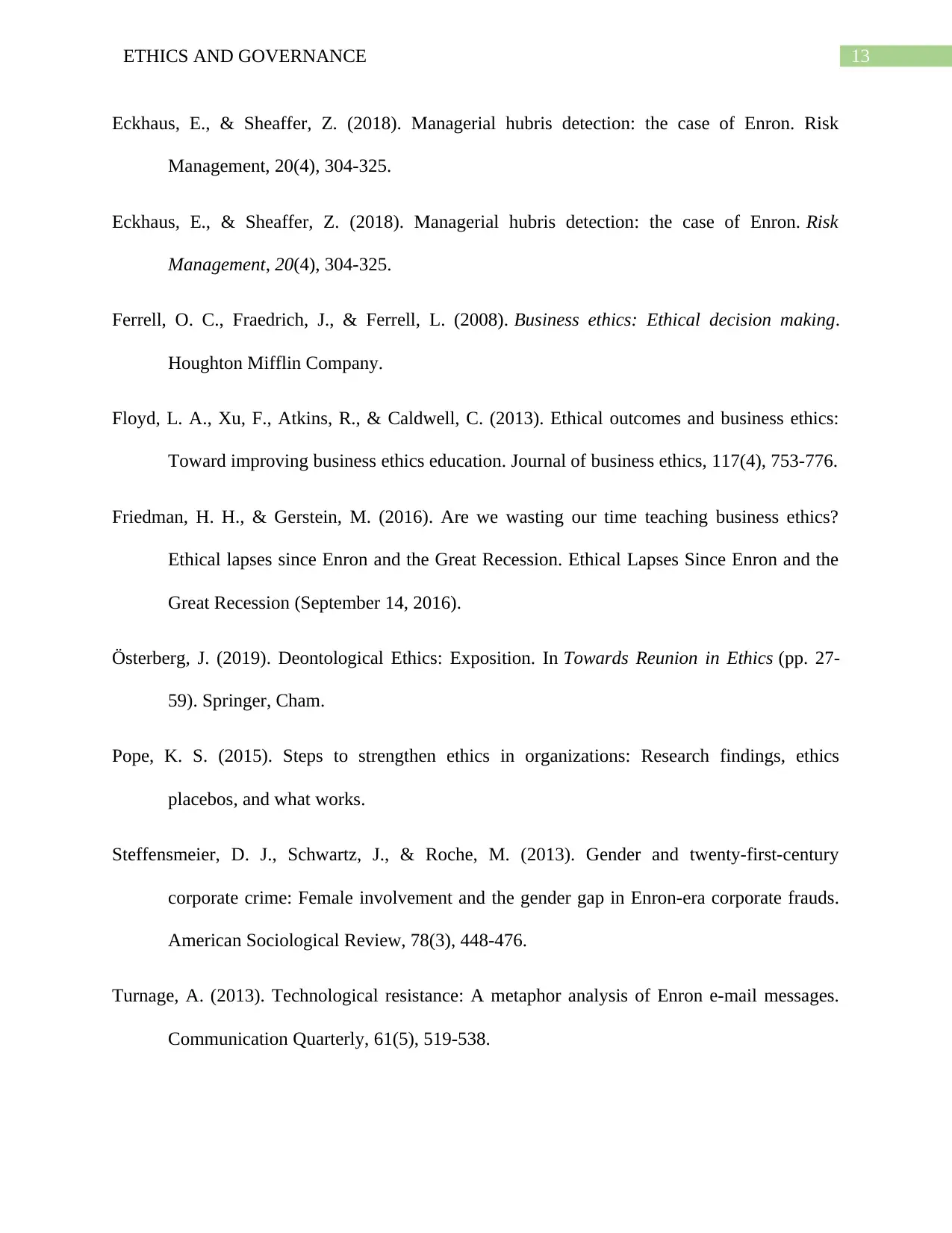
13ETHICS AND GOVERNANCE
Eckhaus, E., & Sheaffer, Z. (2018). Managerial hubris detection: the case of Enron. Risk
Management, 20(4), 304-325.
Eckhaus, E., & Sheaffer, Z. (2018). Managerial hubris detection: the case of Enron. Risk
Management, 20(4), 304-325.
Ferrell, O. C., Fraedrich, J., & Ferrell, L. (2008). Business ethics: Ethical decision making.
Houghton Mifflin Company.
Floyd, L. A., Xu, F., Atkins, R., & Caldwell, C. (2013). Ethical outcomes and business ethics:
Toward improving business ethics education. Journal of business ethics, 117(4), 753-776.
Friedman, H. H., & Gerstein, M. (2016). Are we wasting our time teaching business ethics?
Ethical lapses since Enron and the Great Recession. Ethical Lapses Since Enron and the
Great Recession (September 14, 2016).
Österberg, J. (2019). Deontological Ethics: Exposition. In Towards Reunion in Ethics (pp. 27-
59). Springer, Cham.
Pope, K. S. (2015). Steps to strengthen ethics in organizations: Research findings, ethics
placebos, and what works.
Steffensmeier, D. J., Schwartz, J., & Roche, M. (2013). Gender and twenty-first-century
corporate crime: Female involvement and the gender gap in Enron-era corporate frauds.
American Sociological Review, 78(3), 448-476.
Turnage, A. (2013). Technological resistance: A metaphor analysis of Enron e-mail messages.
Communication Quarterly, 61(5), 519-538.
Eckhaus, E., & Sheaffer, Z. (2018). Managerial hubris detection: the case of Enron. Risk
Management, 20(4), 304-325.
Eckhaus, E., & Sheaffer, Z. (2018). Managerial hubris detection: the case of Enron. Risk
Management, 20(4), 304-325.
Ferrell, O. C., Fraedrich, J., & Ferrell, L. (2008). Business ethics: Ethical decision making.
Houghton Mifflin Company.
Floyd, L. A., Xu, F., Atkins, R., & Caldwell, C. (2013). Ethical outcomes and business ethics:
Toward improving business ethics education. Journal of business ethics, 117(4), 753-776.
Friedman, H. H., & Gerstein, M. (2016). Are we wasting our time teaching business ethics?
Ethical lapses since Enron and the Great Recession. Ethical Lapses Since Enron and the
Great Recession (September 14, 2016).
Österberg, J. (2019). Deontological Ethics: Exposition. In Towards Reunion in Ethics (pp. 27-
59). Springer, Cham.
Pope, K. S. (2015). Steps to strengthen ethics in organizations: Research findings, ethics
placebos, and what works.
Steffensmeier, D. J., Schwartz, J., & Roche, M. (2013). Gender and twenty-first-century
corporate crime: Female involvement and the gender gap in Enron-era corporate frauds.
American Sociological Review, 78(3), 448-476.
Turnage, A. (2013). Technological resistance: A metaphor analysis of Enron e-mail messages.
Communication Quarterly, 61(5), 519-538.
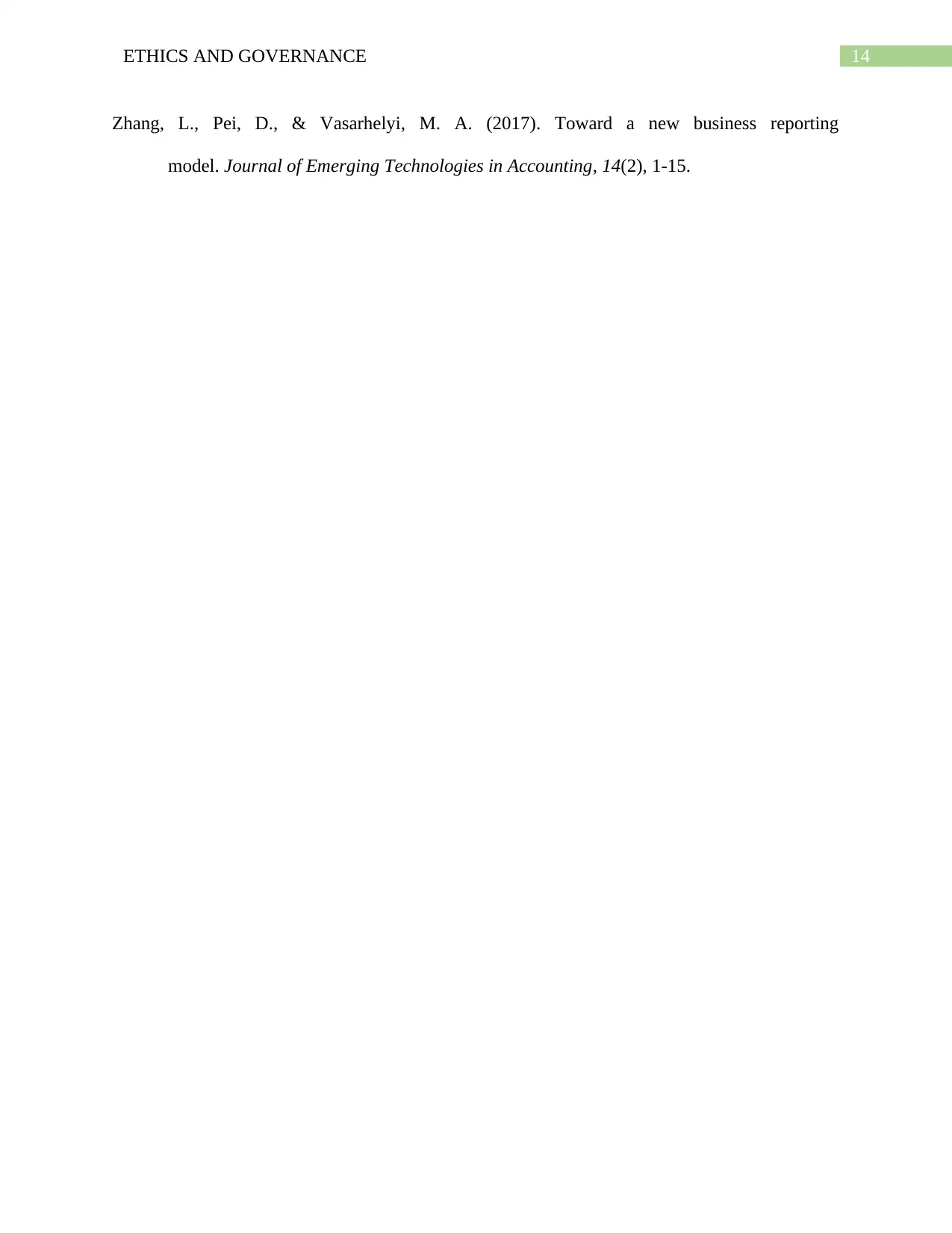
14ETHICS AND GOVERNANCE
Zhang, L., Pei, D., & Vasarhelyi, M. A. (2017). Toward a new business reporting
model. Journal of Emerging Technologies in Accounting, 14(2), 1-15.
Zhang, L., Pei, D., & Vasarhelyi, M. A. (2017). Toward a new business reporting
model. Journal of Emerging Technologies in Accounting, 14(2), 1-15.
1 out of 15
Related Documents
Your All-in-One AI-Powered Toolkit for Academic Success.
+13062052269
info@desklib.com
Available 24*7 on WhatsApp / Email
![[object Object]](/_next/static/media/star-bottom.7253800d.svg)
Unlock your academic potential
© 2024 | Zucol Services PVT LTD | All rights reserved.





